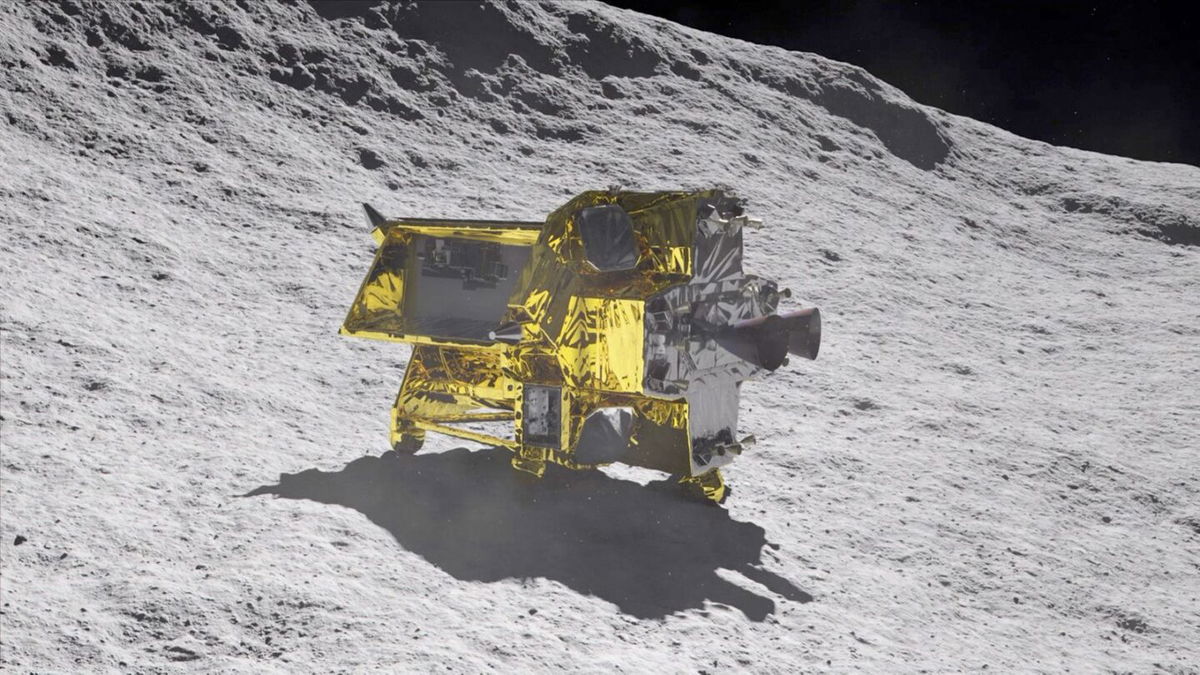Japan’s space agency is about to launch a lunar lander and revolutionary satellite

An artist's rendering shows what SLIM will look like after landing on the lunar surface.
By Ashley Strickland, CNN
(CNN) — A revolutionary satellite that will reveal celestial objects in a new light and the “Moon Sniper” lunar lander are preparing for launch.
The Japan Aerospace Exploration Agency, or JAXA, is expected to launch its XRISM mission, pronounced “crism,” from Japan on Sunday evening.
The satellite, also called the X-Ray Imaging and Spectroscopy Mission, is a joint mission between JAXA and NASA, along with participation from the European Space Agency and Canadian Space Agency.
Along for the ride is JAXA’s SLIM, or Smart Lander for Investigating Moon. This small-scale exploration lander is designed to demonstrate a “pinpoint” landing at a specific location within 100 meters (328 feet), rather than the typical kilometer range, by relying on high-precision landing technology. The precision led to the mission’s nickname, Moon Sniper.
The launch has already been rescheduled twice due to bad weather, and the agency now plans for liftoff of XRISM and SLIM aboard an H-IIA rocket from the Tanegashima Space Center at 8:26 p.m. ET Sunday, or 9:26 a.m. Japan Standard Time on Monday.
The event will stream live on JAXA’s YouTube channel, offering a broadcast in both English and Japanese. The live stream will begin at 7:55 p.m. ET Sunday.
The satellite and its two instruments will observe the universe’s hottest regions, largest structures and objects with the strongest gravity, according to NASA. XRISM will detect X-ray light, a wavelength invisible to humans.
Studying stellar explosions and black holes
X-rays are released by some of the most energetic objects and events in the universe, which is why astronomers want to study them.
“Some of the things we hope to study with XRISM include the aftermath of stellar explosions and near-light-speed particle jets launched by supermassive black holes in the centers of galaxies,” said Richard Kelley, XRISM principal investigator at NASA’s Goddard Space Flight Center in Greenbelt, Maryland, in a statement. “But of course, we’re most excited about all the unexpected phenomena XRISM will discover as it observes our cosmos.”
Compared with other wavelengths of light, X-rays are so short that they pass through the dish-shaped mirrors that observe and collect visible, infrared and ultraviolet light such as the James Webb and Hubble space telescopes.
With that in mind, XRISM has thousands of curved individual nested mirrors better designed to detect X-rays. The satellite will need to calibrate for a few months once it reaches orbit. The mission is designed to operate for three years.
Moon Sniper sets its sights on a crater
Meanwhile, SLIM will use its own propulsion system to head toward the moon. The spacecraft will arrive in lunar orbit about three to four months after launch, orbit the moon for one month, and begin its descent and attempt a soft landing between four to six months after launch.
Unlike other recent lander missions aiming for the lunar south pole, SLIM is targeting a site near a small lunar impact crater called Shioli, in the vicinity of the Sea of Nectar, where it will investigate the composition of rocks that may help scientists uncover the origins of the moon. The landing site is just south of the Sea of Tranquility, where Apollo 11 landed near the moon’s equator in 1969.
Following the United States, the former Soviet Union and China, India became the fourth country to execute a controlled landing on the moon when its Chandrayaan-3 mission arrived Wednesday near the lunar south pole. Previously, Japanese company Ispace’s Hakuto-R lunar lander fell 3 miles (4.8 kilometers) before crashing into the moon during a landing attempt in April.
The-CNN-Wire
™ & © 2023 Cable News Network, Inc., a Warner Bros. Discovery Company. All rights reserved.